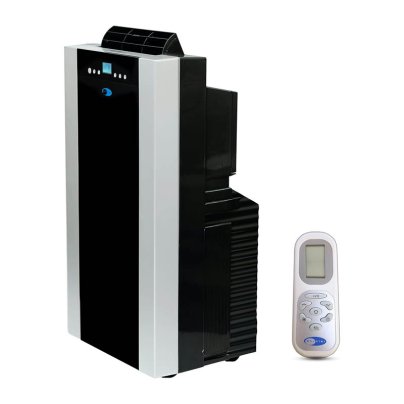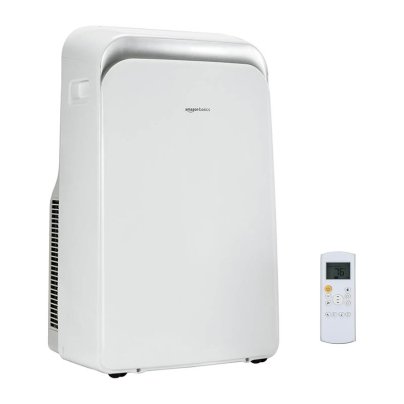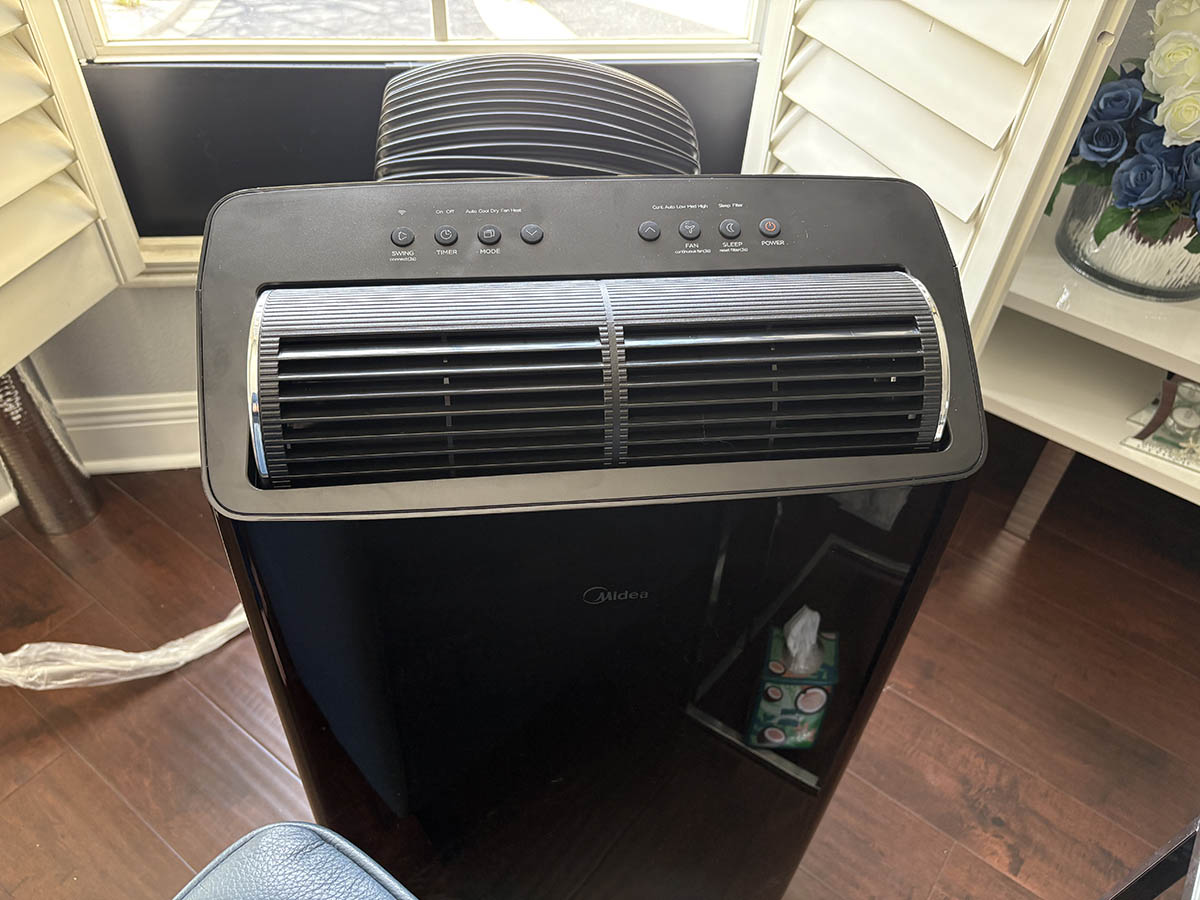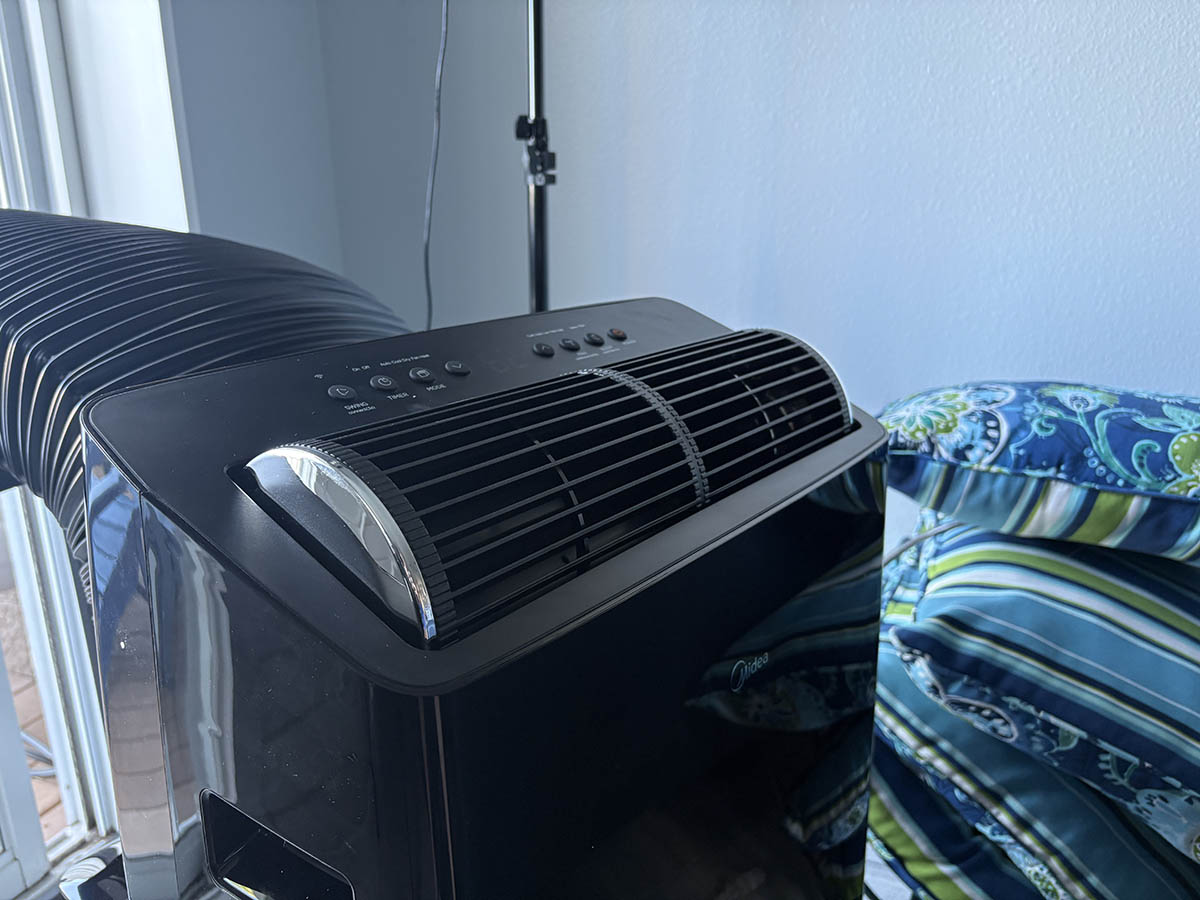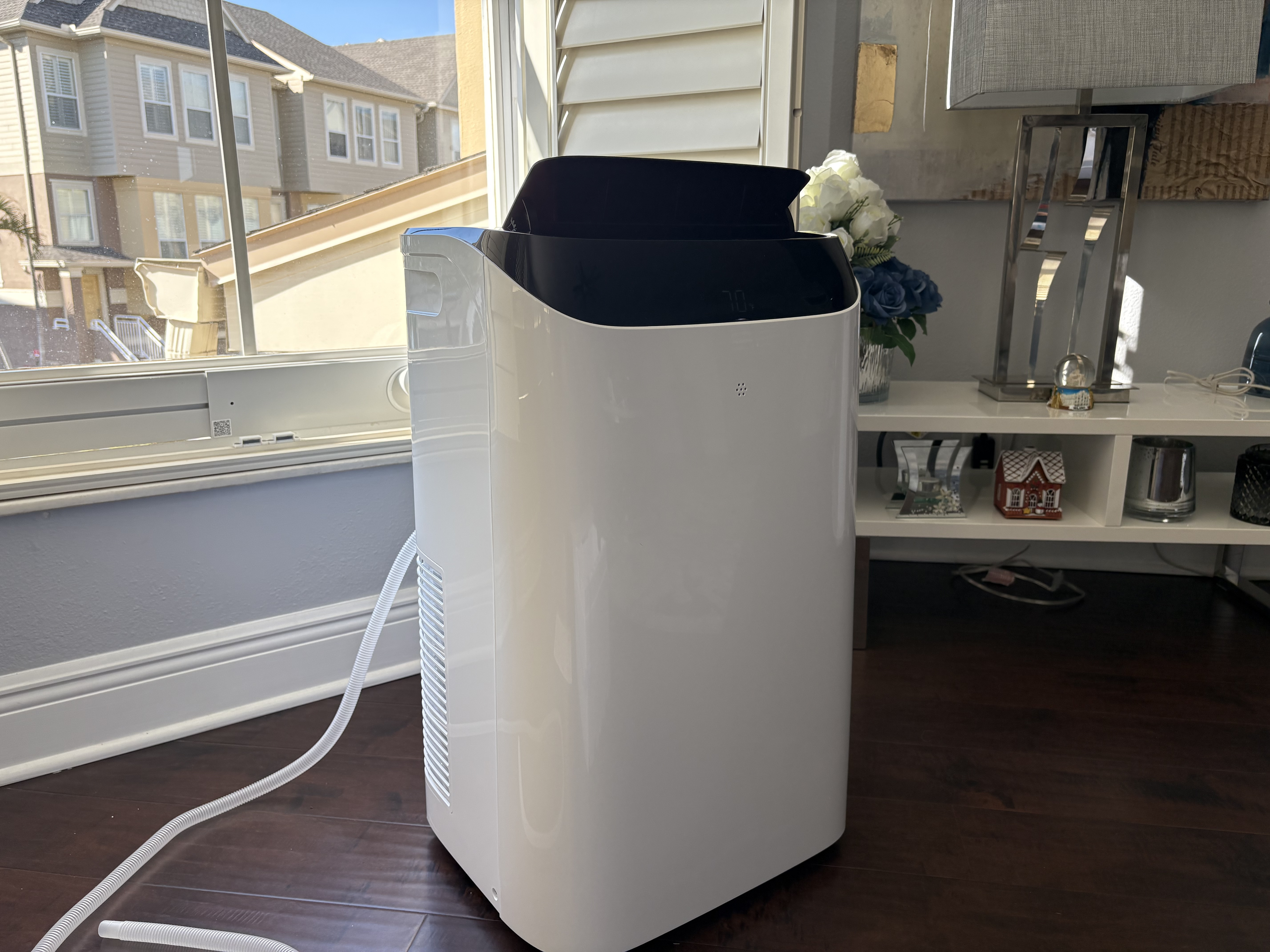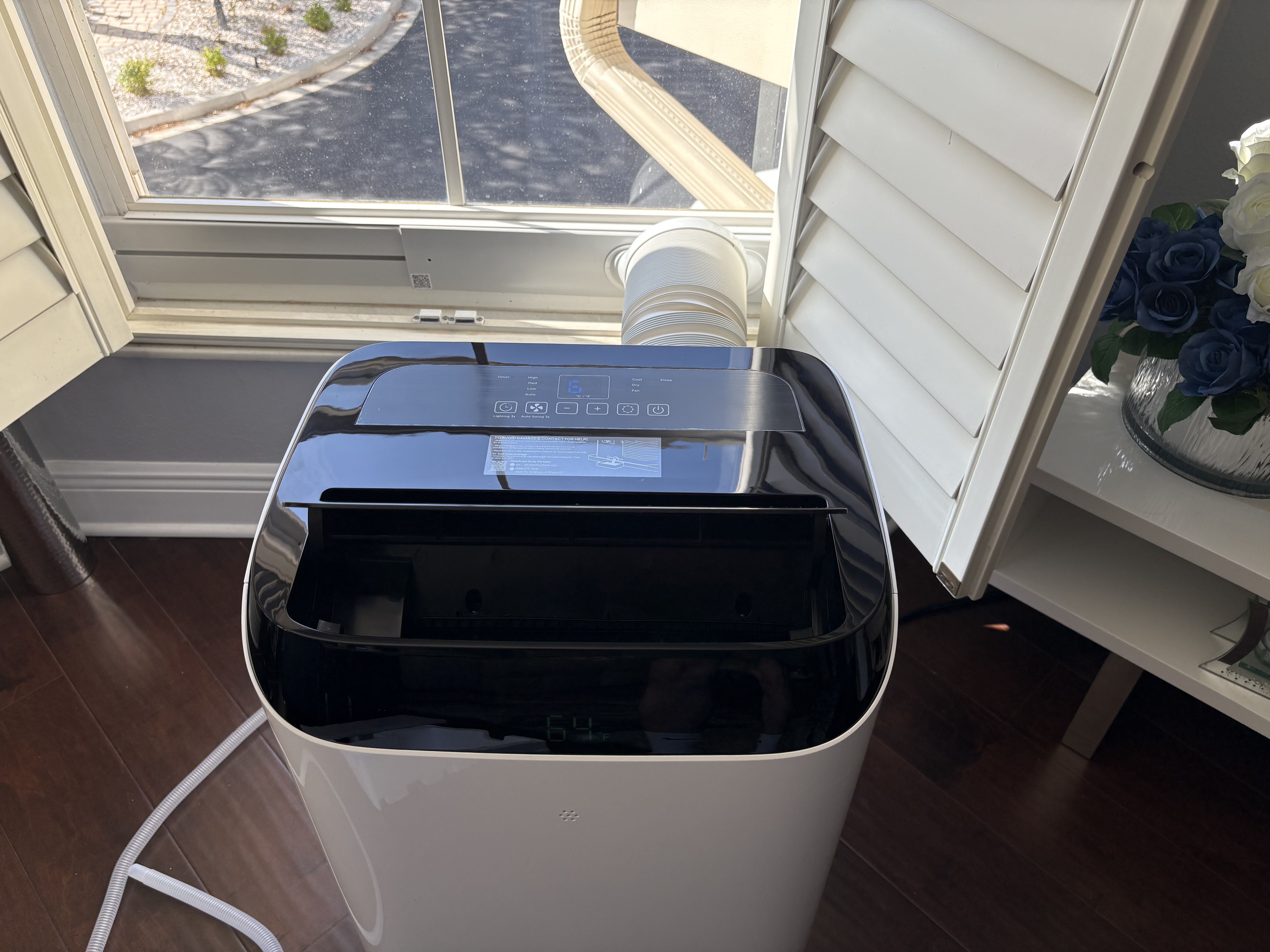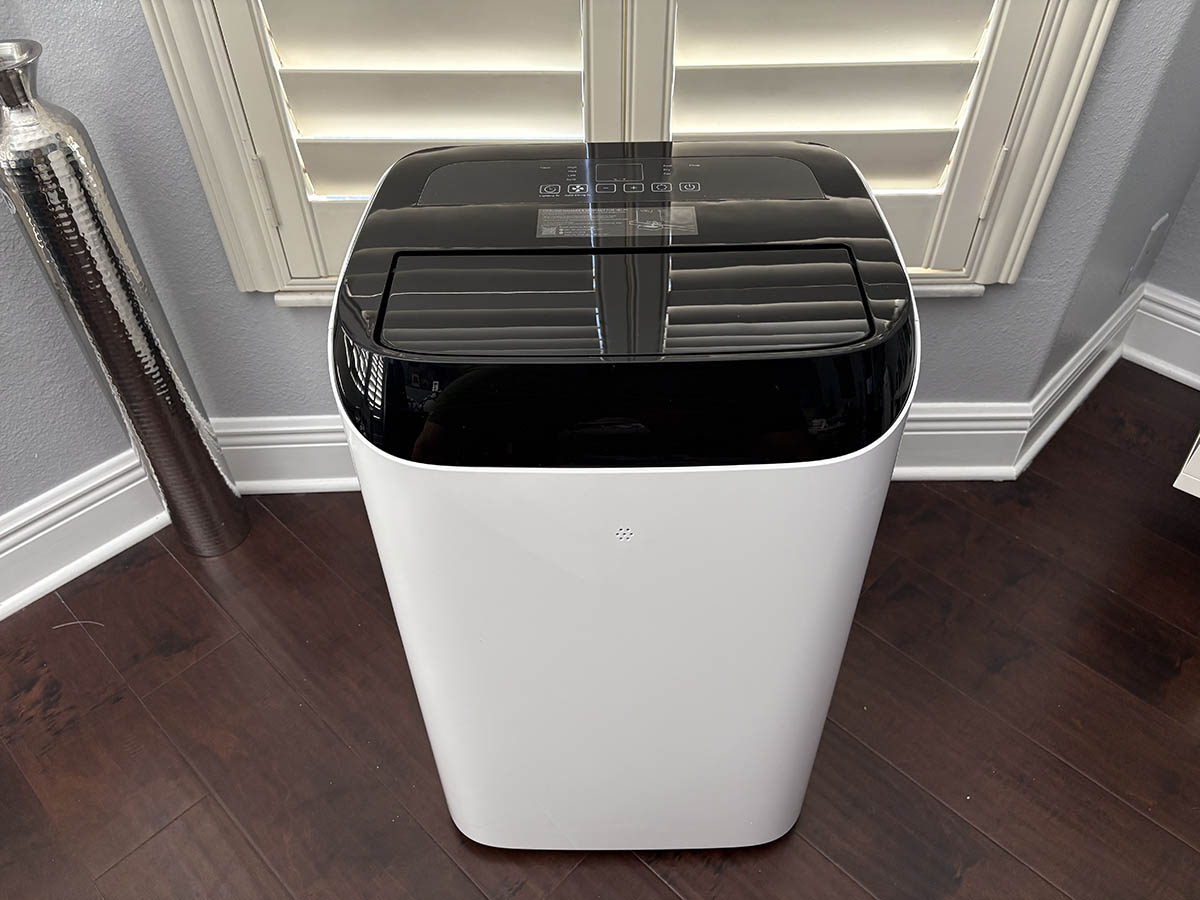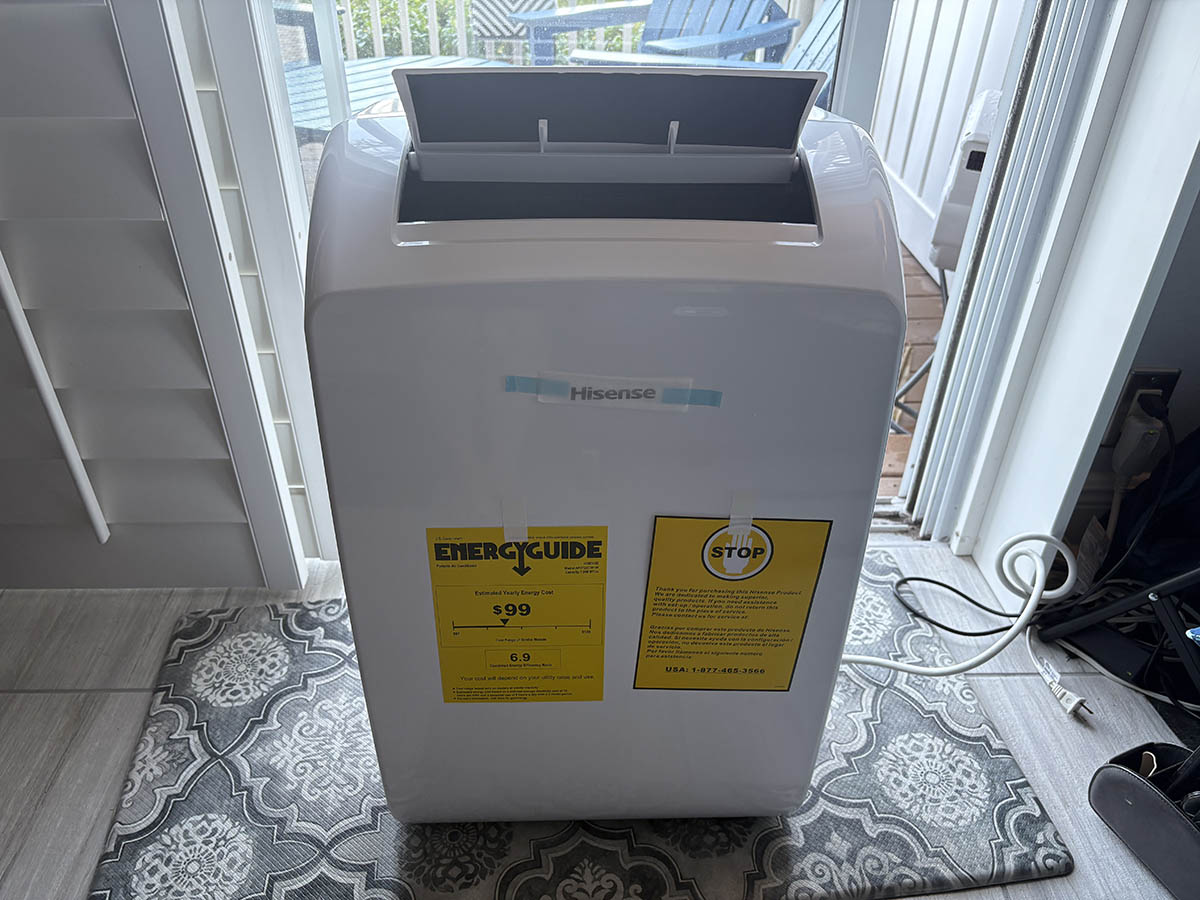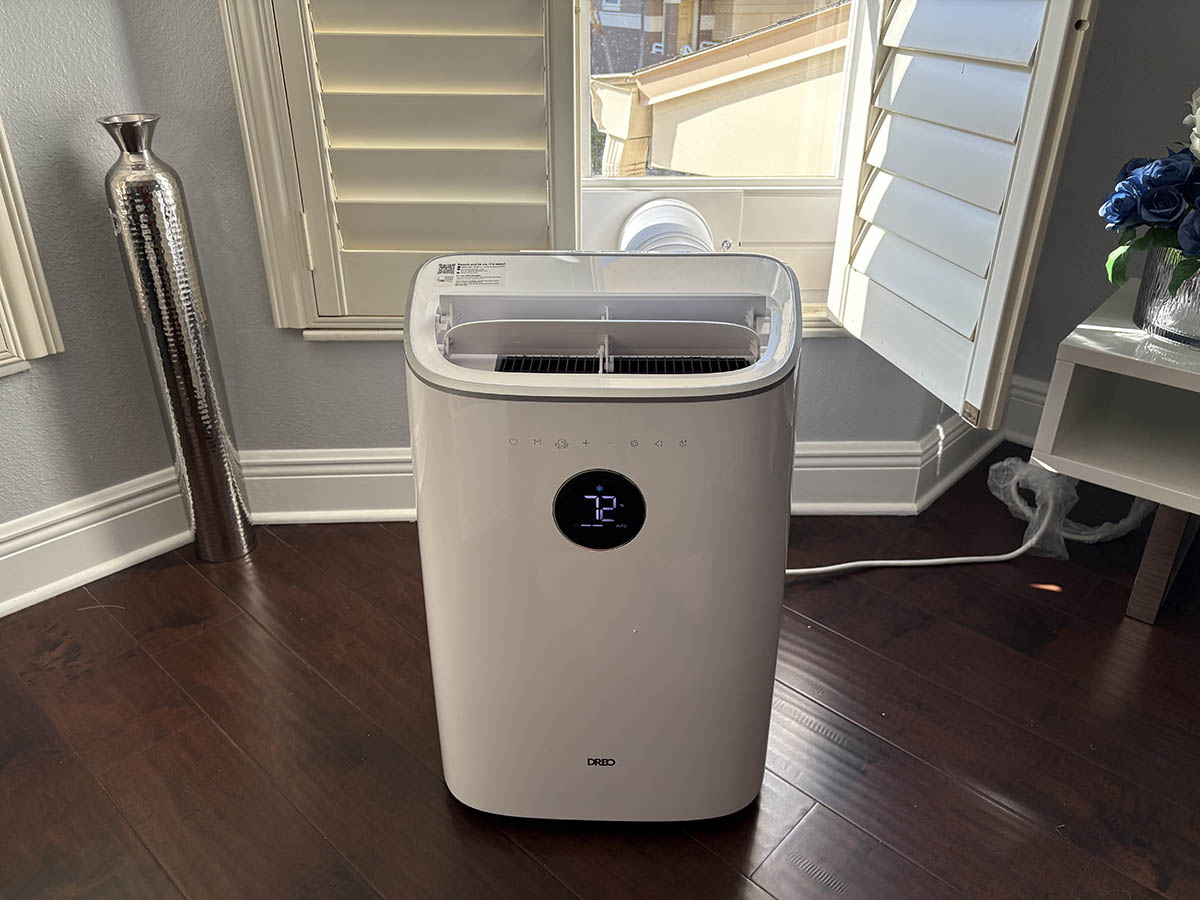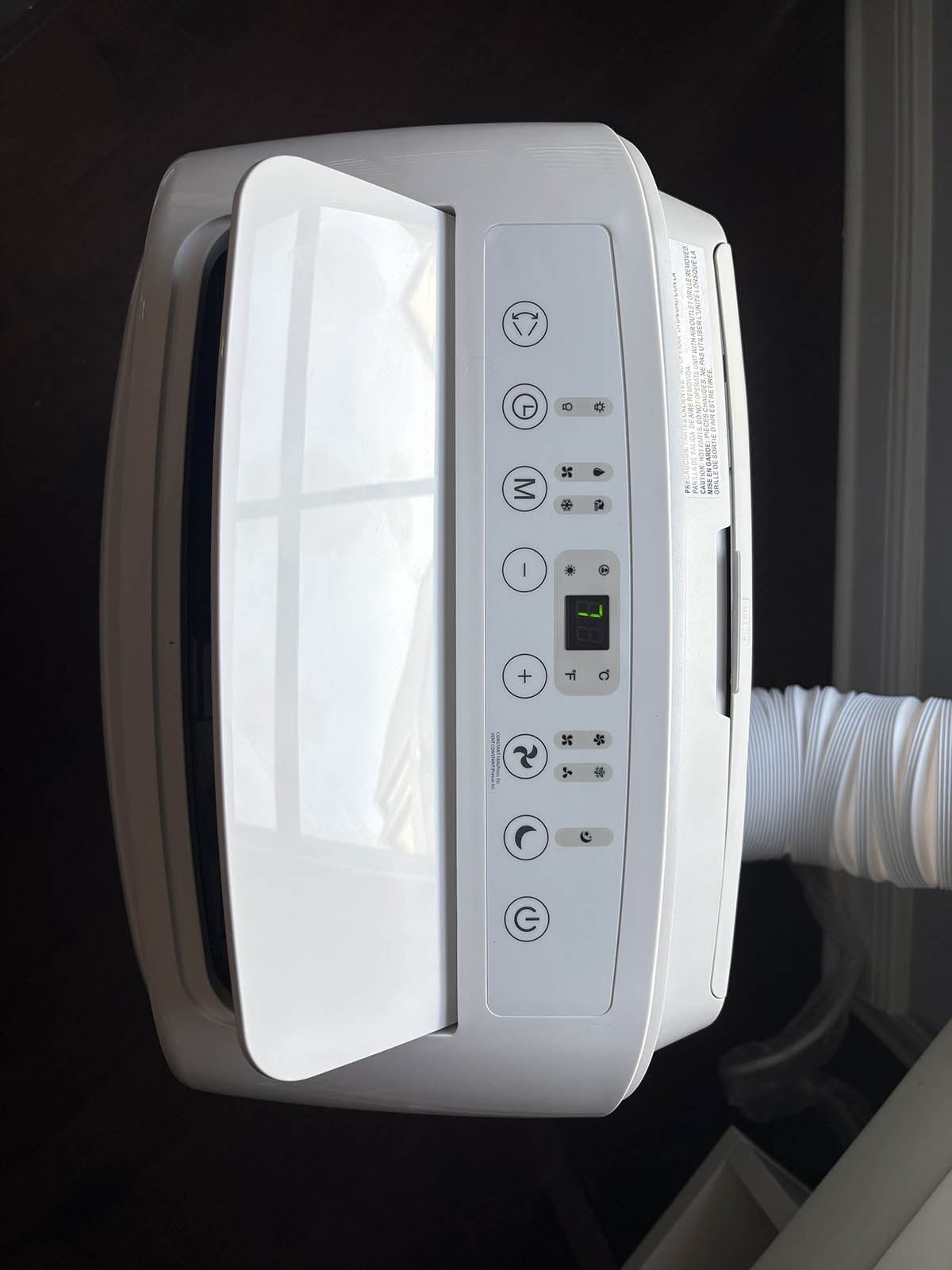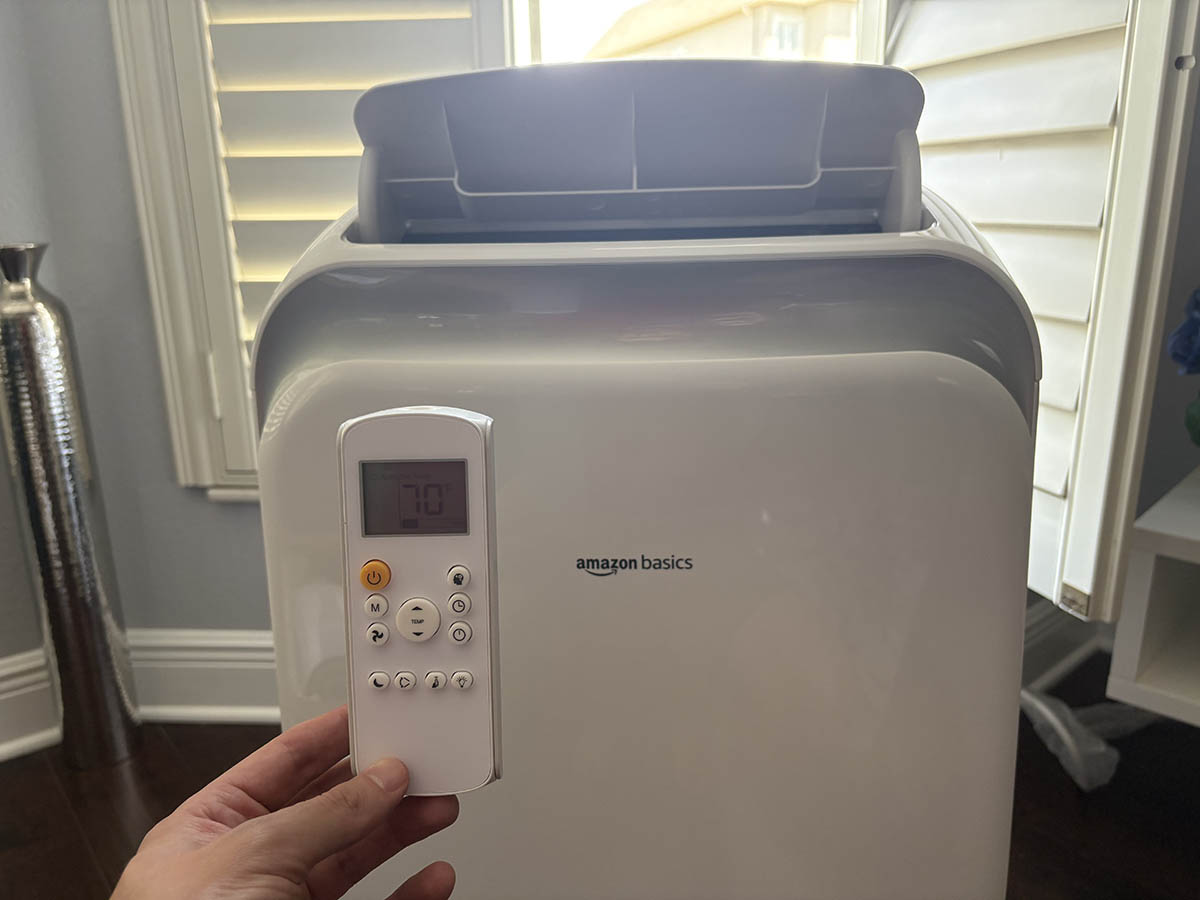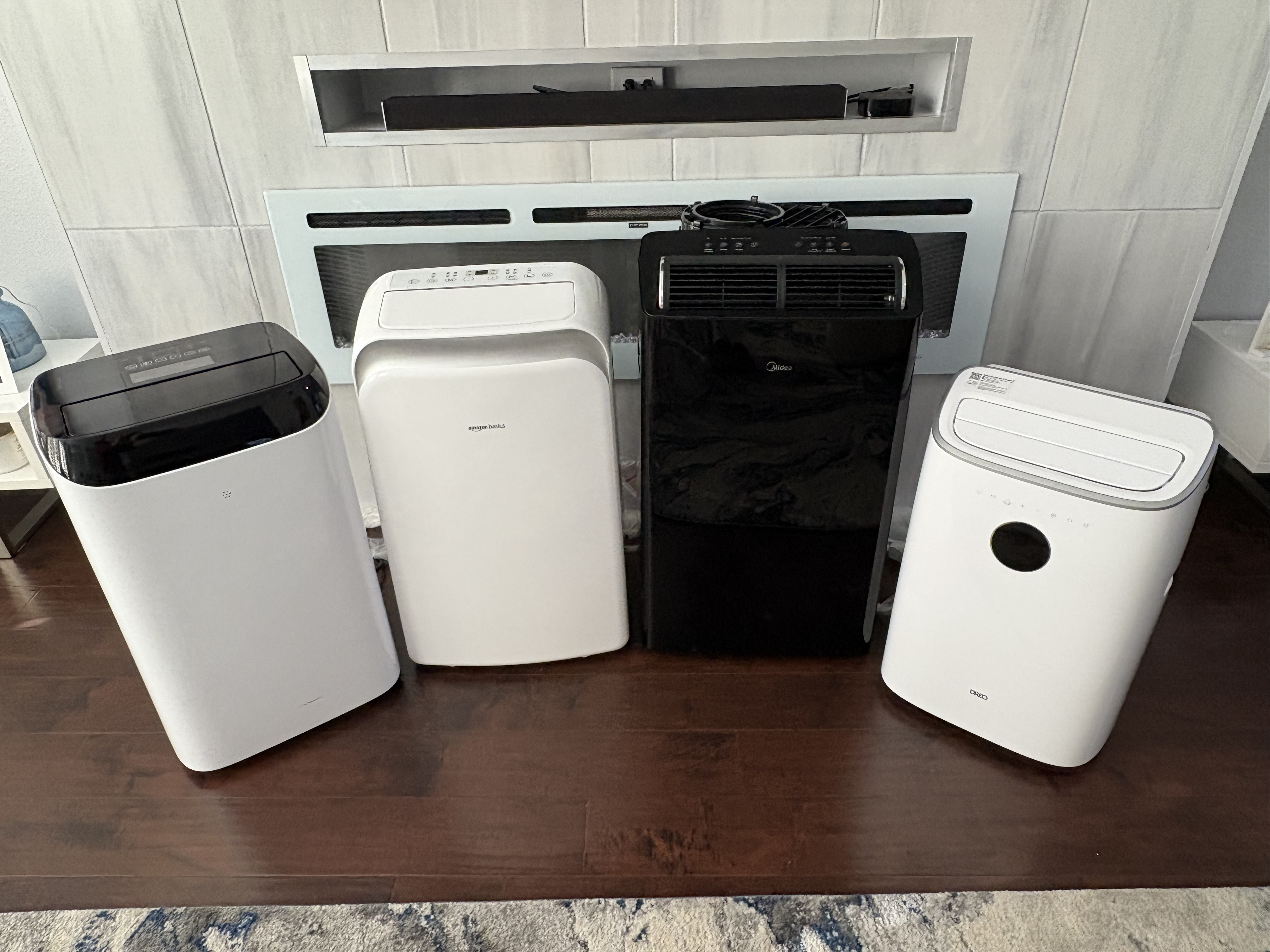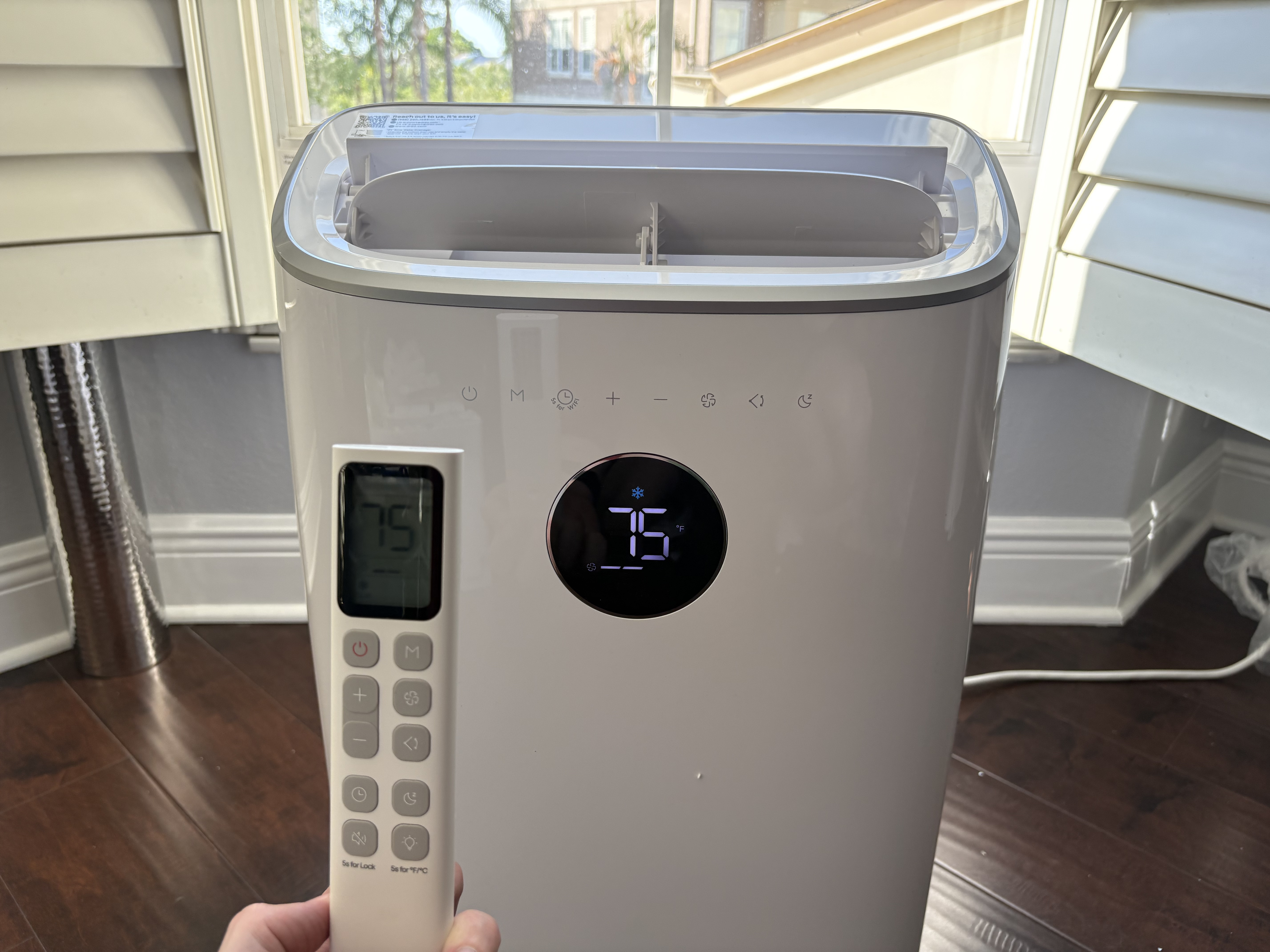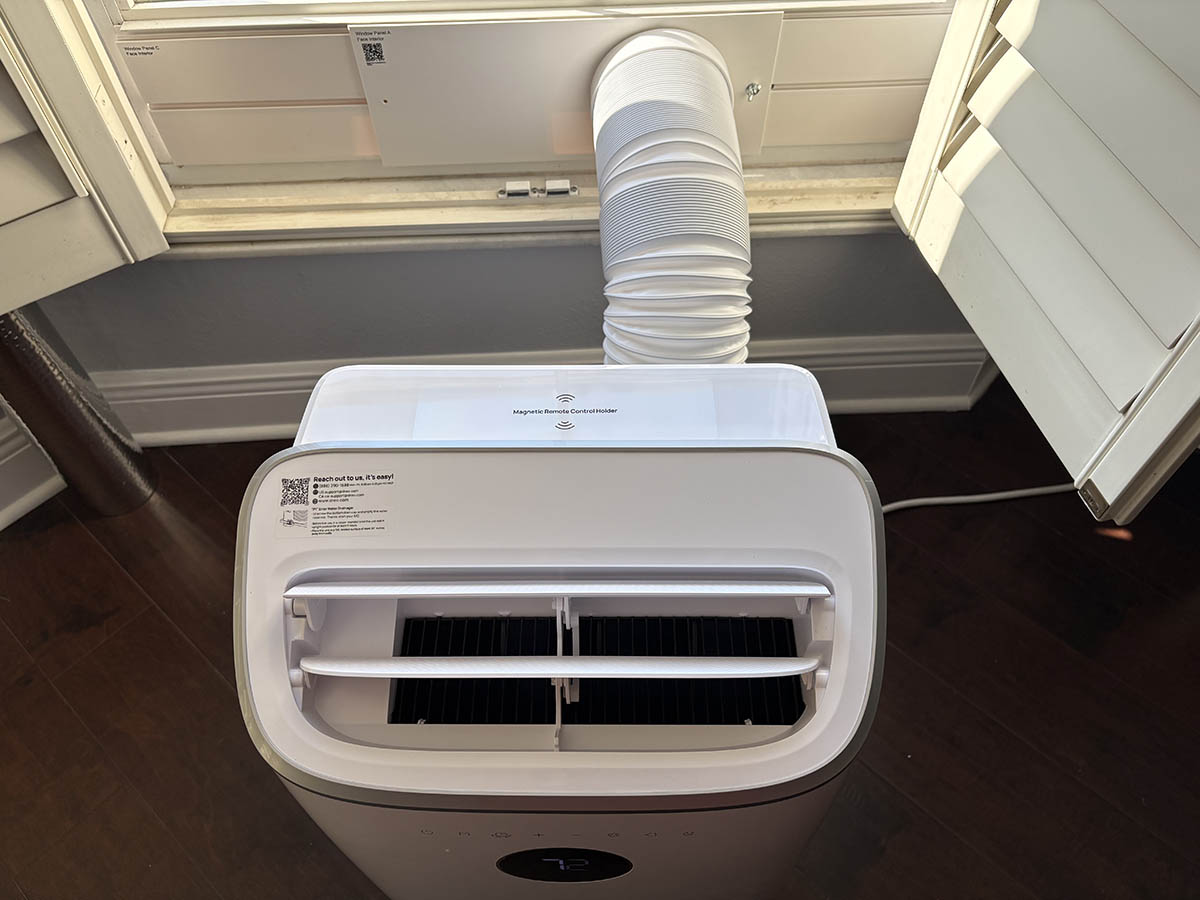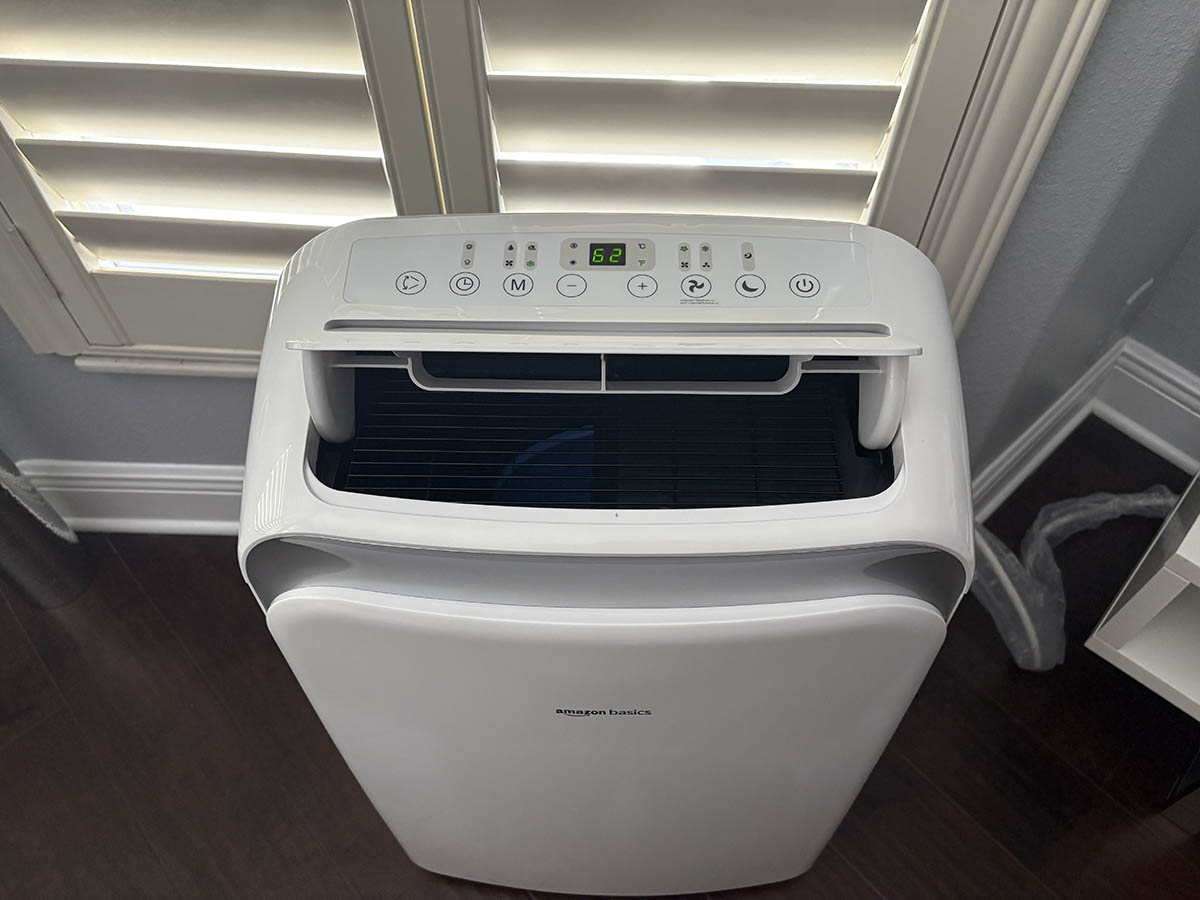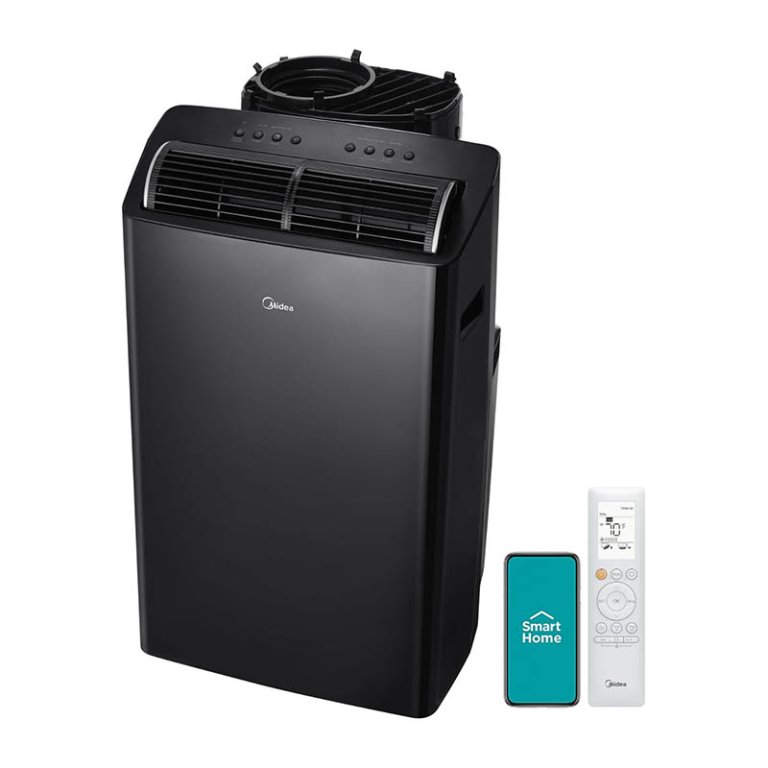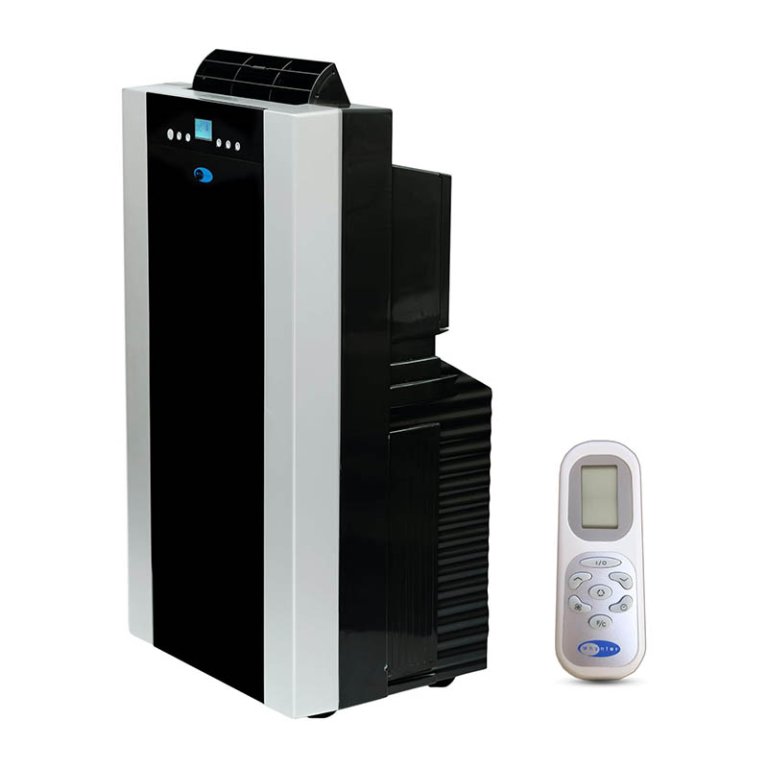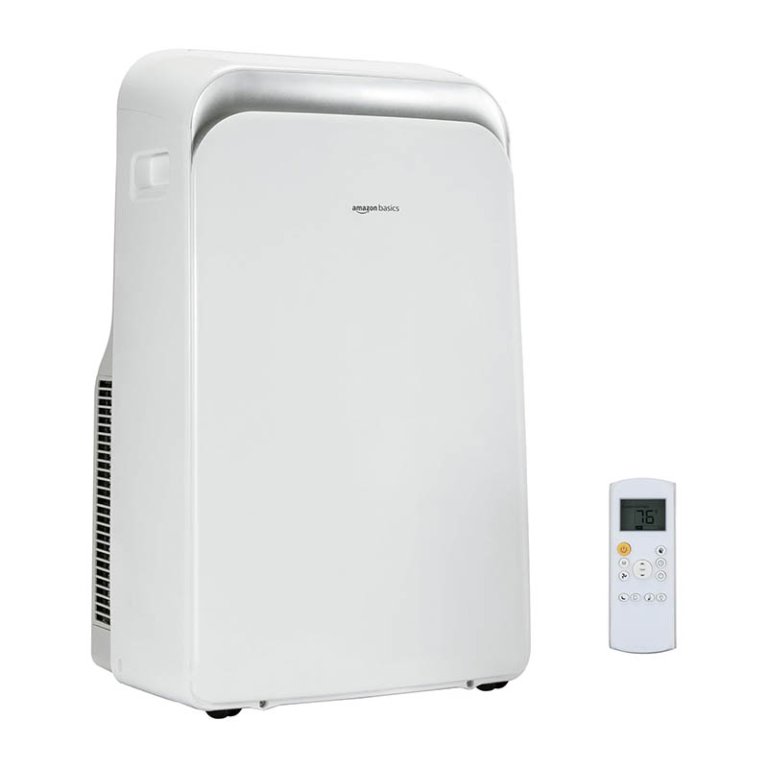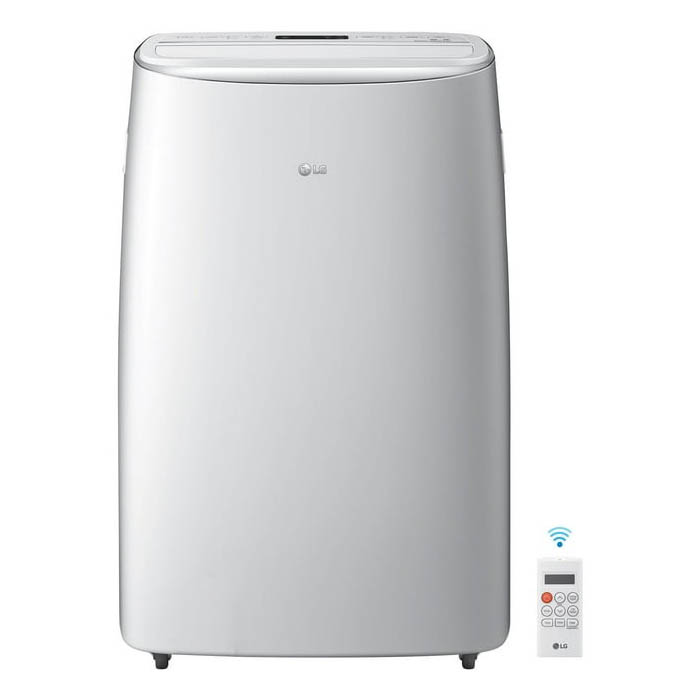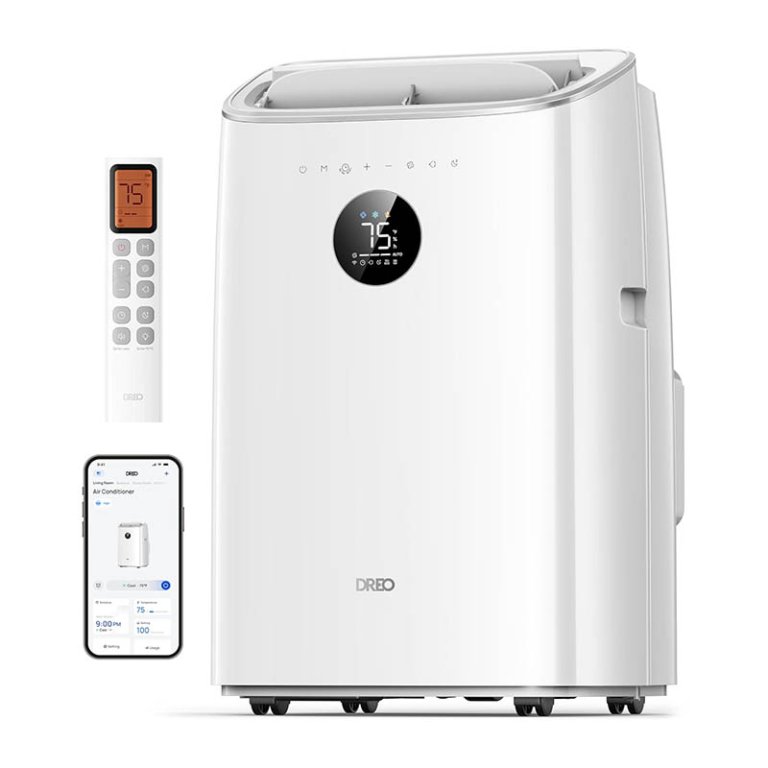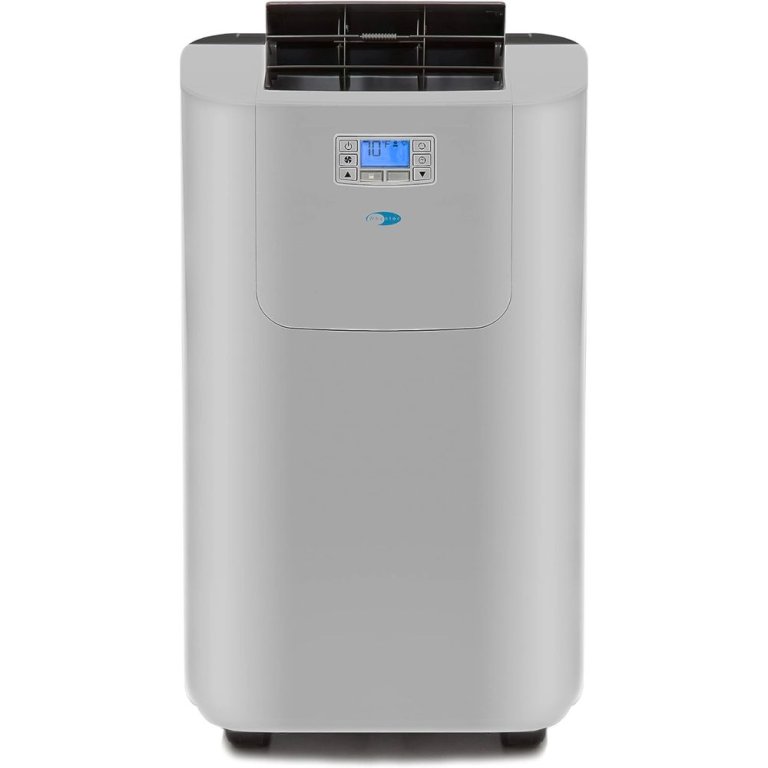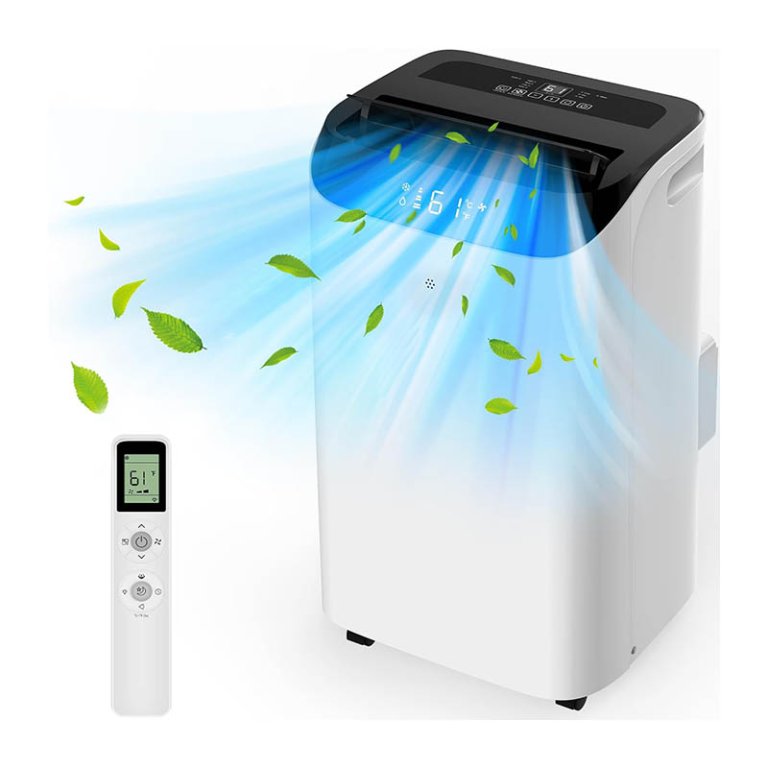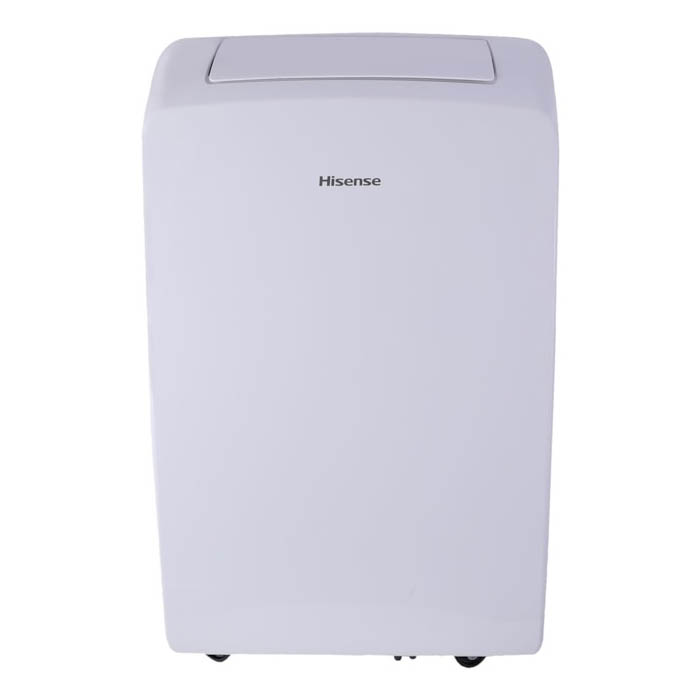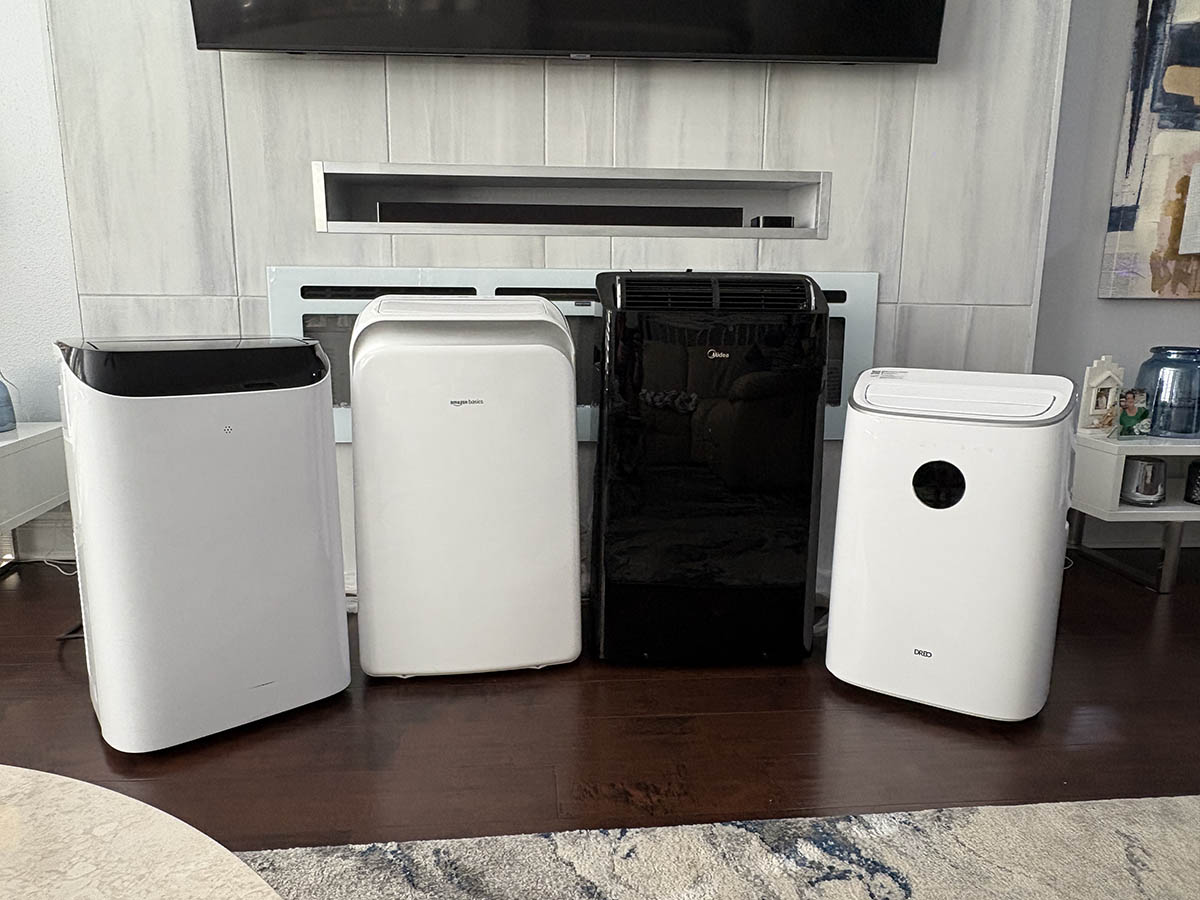
We may earn revenue from the products available on this page and participate in affiliate programs. Learn More ›
True to their name, portable air conditioners sit entirely inside the home and transfer heat outdoors via an exhaust hose, making them far more convenient than most other cooling solutions. A portable AC unit sits entirely inside the home, transferring heat to the outdoors via an exhaust hose.
While they take up floor space and don’t run quite as efficiently as their in-window counterparts, they’re your best bet (or only bet) in many scenarios. We researched and tested a variety of portable air conditioning units in 90+ degree Fahrenheit Florida weather with humidity levels between 70 and 80 percent to see which units performed best and kept our area cool and comfortable. Our favorite is the Midea Duo Portable Air Conditioner thanks to its powerful cooling and heating capabilities, energy efficiency, and unique voice-control feature.
We also reached out to Glenn Gault, CEO of Gault Heating & Cooling, located in Northeast Ohio, to get his expert opinion. Continue reading for tips on how to choose the best portable air conditioners for your space, and find out how the models we tested performed.
- BEST OVERALL: Midea Duo Portable AC With Heat
↓ Jump to Review - RUNNER-UP: Whynter ARC-14S Dual Hose Portable Air Conditioner
↓ Jump to Review - BEST BANG FOR THE BUCK: Amazon Basics Portable Air Conditioner
↓ Jump to Review - BEST SMART: LG Smart Dual Inverter Portable Air Conditioner
↓ Jump to Review - BEST APP: Dreo AC319S Smart Air Conditioner
↓ Jump to Review - BEST FOR SMALL ROOMS: Whynter Elite ARC-122DS Portable Air Conditioner
↓ Jump to Review - BEST QUIET: Humhold Portable Air Conditioner
↓ Jump to Review - BEST FOR HUMIDITY: Hisense Portable Air Conditioner With WiFi
↓ Jump to Review

Portable Air Conditioners Comparison
| Product | BTU | Decibel level (lowest setting) | Weight |
| Midea Duo Portable AC With Heat | 14,000 BTU | 42 dB | 77.16 pounds |
| Whynter ARC-14S Dual Hose Portable Air Conditioner | 14,000 BTU | ≤ 51 dB | 73 pounds |
| Amazon Basics Portable Air Conditioner | 10,000 BTU | Not listed (but it’s quiet) | 75.18 pounds |
| LG Smart Dual Inverter Portable Air Conditioner | 10,000 BTU | ≤ 44 dB | 70.99 pounds |
| Dreo AC319S Smart Air Conditioner | 10,000 BTU | 45 dB | 57.2 pounds |
| Whynter Elite ARC-122DS Portable Air Conditioner | 12,000 BTU | ≤ 47 dB | 68 pounds |
| Humhold Portable Air Conditioner | 14,000 BTU | ≤ 48 dB | 65 pounds |
| Hisense Portable Air Conditioner With WiFi | 7,000 BTU | 49 dB | 58.4 pounds |
Our Top Picks
The following products represent some of the best portable AC units on the market today. See how each one fared in our tests, including the various functions offered and the overall cooling efficiency.
Best Overall
Midea Duo Portable AC With Heat
See ItWhat We Like
- Strong cooling with powerful fan speeds
- Smart controls via app and remote
- Smooth-rolling wheels for easy movement
- Helpful installation video available
What We Don’t Like
- Heavy; hard to move between floors
- Minor water leakage when moving
Specs
- BTU: 14,000
- Decibel level at lowest setting: 42 dB
- Weight: 77.16 pounds
Our Ratings: Ease of Use 5/5; Performance 5/5; Noise 3.5/5; Portability 4/5; Value 5/5
The Midea Duo Portable Air Conditioner stood out as the most powerful and well-rounded unit in our testing, especially during the sweltering Florida heat. With temperatures topping 93 degrees Fahrenheit and humidity pushing 80 percent, this portable AC didn’t flinch. It uses a dual-hose system, which helps it cool more efficiently than many single-hose models, and once the initial setup was done, it delivered a strong, steady stream of cold air that dropped the room temperature fast. The high fan speed is loud, but that’s expected given the power—it rarely needed to stay on high for long before switching to a quieter, more comfortable hum on auto mode.
Installation took a bit of time, mostly due to adjusting the window panel for the exhaust hose, but the unit itself was easy to set up once that part was done. The printed instruction manual is thorough, but for those who prefer to skip straight to the essentials, there’s a clear, well-made 5-minute install video available on YouTube. We also appreciated the thoughtful extras, like smooth-rolling wheels for easy movement between rooms and the option to control settings via the app or remote control—no need to walk over to the unit every time.
Overall, this is a versatile, high-performance freestanding air conditioner for cooling indoor spaces quickly and effectively.
What our tester says: “I totally get why this unit is a step up in price compared to the others. It really pumps out the cold air like no other portable AC I’ve seen. If you need to cool down a large space quickly, this is the one you want.”—Paul Rankin, Product Reviews tester and writer.
Read our full review: Midea Duo portable air conditioner review
Get the Midea Duo portable air conditioner at Amazon, Lowe’s, or Midea.
Runner-up
Whynter ARC-14S Dual Hose Portable Air Conditioner
See ItWhat We Like
- Powerful cooling ability
- Effective in spaces of up to 500 square feet
- Included remote control
- Dehumidifier mode available
- Rolling wheels for easier transport
What We Don’t Like
- Heavy and difficult to move from floor to floor
Specs
- BTU: 14,000
- Decibel level at lowest setting: ≤ 51 dB
- Weight: 73 pounds
Our Ratings: Ease of Use 5/5; Performance 5/5; Portability 2/5; Noise 4/5; Value 4/5
For a reasonable price, this Whynter dual-hose portable room air conditioner features a maximum output of 14,000 BTU and is suitable for rooms up to 500 square feet in size.
The portable AC unit can be set to cooling, fan-only, or dehumidifier mode. The fan speed in the cooling and fan mode can be adjusted between low, medium, and high to meet your personal preferences. The unit sits on four wheels, making it easy to move around and set up within the home.
This was among the most powerful portable AC units we tested. Setup took a few minutes as we connected each hose to the back of the unit and screwed the window panel in.
We turned the unit on when our 600-square-foot room reached 80 degrees Fahrenheit. The unit was set to the lowest cooling setting at 61 degrees Fahrenheit and the highest fan setting. Cold air was instantly pushed through the top vent, and the room was noticeably cooler within 10 minutes. Where traditional portable air conditioners are bulky, this model is sleek stainless steel and slimmer than most.
Read our full review: Whynter ARC-14S Dual Hose Portable Air Conditioner
Get the Whynter ARC-14S portable air conditioner at Amazon, The Home Depot, or Best Buy.
Best Bang for the Buck
Amazon Basics Portable Air Conditioner
See ItWhat We Like
- Quiet operation
- Compact size yet still powerful
- Great price for what it offers
What We Don’t Like
- No batteries for the remote
Specs
- BTU: 10,000
- Decibel level at lowest setting: Not listed (but it’s quiet)
- Weight: 75.18 pounds
Our Ratings: Ease of Use 5/5; Performance 4.5/5; Noise 5/5; Portability 5/5; Value 4.3/5
The Amazon Basics Portable Air Conditioner is a solid, budget-friendly choice for those who want straightforward cooling without extra bells and whistles. We tested this unit in Florida during a stretch of hot, humid weather, and it delivered consistent performance while keeping the setup process refreshingly simple. The adjustable window panel fits most standard sash windows, and the exhaust hose clicks easily into place—no tools or frustration required. It’s also more compact than many other models we tested, making it a smart pick for smaller rooms or tight spaces. For solo use or home offices, it even doubles nicely as a personal air conditioner.
This model doesn’t try to overcomplicate things. The controls are simple and intuitive, and while the buttons on the unit itself feel a little on the cheap side, the included remote control gives you all the functionality you need from across the room. Our only gripe: the remote requires two AAA batteries, which aren’t included.
Fan speed and cooling power are well-suited for average-size rooms, and the unit stays quiet once it hits the target temperature, maintaining comfort without drawing attention.
What our tester says: “This is a no-fuss, efficient portable AC that’s great for renters, small rooms, or anyone looking for a reliable unit at a lower price point. I appreciated the simple controls and impressive cooling at a decent price.”—Paul Rankin, Product Reviews tester and writer.
Get the Amazon Basics portable air conditioner at Amazon.
Best Smart
LG Smart Dual Inverter Portable Air Conditioner
See ItWhat We Like
- Built-in dehumidifier
- Works with smartphones for easy adjustments and monitoring
- Easy to set up; can be fully put together in minutes
What We Don’t Like
- Heavy and less portable than comparable top picks
Specs
- BTU: 10,000
- Decibel level at lowest setting: ≤ 44 dB
- Weight: 70.99 pounds
Our Ratings: Ease of Use 5/5; Performance 4/5; Portability 3/5; Noise 4/5; Value 4/5
The LG LP1419IVSM smart portable air conditioner features dual-inverter technology for faster, more efficient cooling. It offers three cooling and fan speeds, a 24-hour timer, and smartphone control via LG ThinQ. It also functions as a dehumidifier to reduce excess moisture.
During testing, we found that this unit was among the quietest to run. While it ran in sleep mode, we measured its noise output at 42 to 45 decibels, which was quiet enough for us to comfortably watch TV while it was running. We tested this unit in our 600-foot living space. It cooled the area efficiently and kept it at a comfortable temperature. When we tested the LG ThinQ app, we were able to easily pair the unit with two different smartphones with no issue. The app allowed us to control the unit and set an operating schedule.
Our favorite part of using the LG portable air conditioner was its ease of setup; we had this unit installed within minutes. The air conditioner vent is built into the back of the unit, so there is no fumbling with hose assembly. Plus, the hose and venting mount are among the best quality we’ve dealt with. The unit has a sleek appearance and is beautifully designed.
Get the LG portable air conditioner at Walmart or Best Buy.
Best App
Dreo AC319S Smart Air Conditioner
See ItWhat We Like
- Best-looking unit we tested
- Convenient smart features
- Magnetic strip to store the remote
- Smartphone and voice integration
What We Don’t Like
- Not quite as powerful as other models
Specs
- BTU: 10,000
- Decibel level at lowest setting: 45 dB
- Weight: 57.2 pounds
Our Ratings: Ease of Use 5/5; Performance 4.8/5; Noise 4.5/5; Portability 5/5; Value 5/5
The Dreo AC319S Smart Portable Air Conditioner impressed us on nearly every front during testing, quickly becoming one of our favorites of the bunch. Tested in Florida’s intense heat and humidity, this model proved that great things can come in compact, quiet, and beautifully designed packages. At first glance, it’s clear that Dreo put serious thought into both function and aesthetics. It’s the most compact and lightweight mini air conditioner we tested, making it easy to move between rooms or up and down stairs. But it’s the thoughtful details—like the magnetic remote storage strip on top, elegant circular LCD screen, and seamless smart app integration—that really set this one apart.
The Dreo app lets you adjust fan speeds, modes, and schedules remotely, and it supports voice control via Alexa or Google Assistant, making it one of the most user-friendly models we’ve tried. The flexible, extended-length drain hose simplifies setup, and its whisper-quiet operation stood out immediately. While it doesn’t blast cold air quite as aggressively on high as some of the more powerful models, it cools effectively and maintains that cool quietly—ideal for bedrooms, offices, or shared spaces where noise matters. The touchscreen buttons are sleek and responsive, and the whole unit just feels premium from top to bottom.
Note: We previously tested the Dreo AC516S, another strong performer from the brand, and were equally impressed with its powerful cooling and smart features. Read our full review of that model here: Dreo AC516S review.
Get the Dreo AC319S portable air conditioner at Amazon or Dreo.
Best for Small Rooms
Whynter Elite ARC-122DS Portable Air Conditioner
See ItWhat We Like
- Built-in dehumidifier
- Compatible with Amazon Alexa
- Quiet operation; ideal for bedrooms
What We Don’t Like
- No Energy Star certification; not as efficient as comparable options
Specs
- BTU: 12,000
- Decibel level at lowest setting: ≤ 47 dB
- Weight: 68 pounds
Our Ratings: Ease of Use 4/5; Performance 5/5; Portability 4/5; Noise 3/5; Value 4/5
The Whynter ARC-122DS stand-up air conditioner’s sleek appearance helps it fit in with the design of most rooms. The sturdy wheeled base improves its portability, allowing it to be moved around on a flat surface easily, despite its 68-pound weight. It has a maximum output of 12,000 BTU, ensuring that it can rapidly cool a room up to 400 square feet in size.
This unit was among some of the most powerful on the list and is ideal for a smaller bedroom, apartment, or office. Thanks to its dual-inverter technology, it cooled off our space quickly. We also liked how quiet it was when running at the highest setting, which was ideal for a bedroom.
When the humidity rose, the unit was able to keep up with the increased temperature and keep our living area more comfortable than some of the other units we tested. The stainless steel adds an elegant look as well.
Get the Whynter Elite portable air conditioner at The Home Depot, Wayfair, Walmart, or Best Buy.
Best Quiet
Humhold Portable Air Conditioner
See ItWhat We Like
- Sleek modern design
- Long and flexible drain hose
- LCD screen and buttons look and feel great
What We Don’t Like
- Power cord is a little short
Specs
- BTU: 14,000
- Decibel level at lowest setting: ≤ 48 dB
- Weight: 65 pounds
Our Ratings: Ease of Use 5/5; Performance 5/5; Noise 4/5; Portability 5/5; Value 5/5
The Humhold Portable Air Conditioner stood out as one of the top performers in our testing, thanks to its thoughtful design and incredibly smooth setup process. In steamy Florida conditions, it delivered reliable cooling while being the easiest unit to install. The exhaust hose clicks effortlessly into place on the back and connects to a slim, low-profile window panel that takes up minimal space—a small but smart detail. It also comes with a flexible, long drainage hose that plugs directly into the back—far superior to the stiff, short tubes included with most other units.
This quiet portable air conditioner also scores high marks for style and build quality. It’s compact and modern, with a crisp white body and a glossy black top that looks more upscale than the price tag suggests. The touchscreen controls are sleek and responsive, and the remote works beautifully—batteries included, which we appreciated. The only real drawback is the shorter power cord, though it still reached a nearby outlet without issue.
The Humhold did prove to be one of the quietest units we tested. Even on high, it runs with a noticeably softer hum than other models in its class while still delivering a strong blast of cold air. On low or auto mode, it’s barely audible—ideal for light sleepers or anyone using it in a bedroom or home office. With basic but reliable features like cool, dry, fan, sleep modes, and a timer, this unit is both user-friendly and efficient.
Get the Humhold portable air conditioner at Amazon or Humhold.
Best for Humidity
Hisense Portable Air Conditioner With WiFi
See ItWhat We Like
- Good as a backup AC unit
- No drain hose needed
- Great at handling high humidity
What We Don’t Like
- High setting was the loudest of all models
- “Waterless,” but still need to empty the water out
Specs
- BTU: 7,000 (SACC)
- Decibel level at lowest setting: 49 dB
- Weight: 58.4 pounds
Our Ratings: Ease of Use 5/5; Performance 3.8/5; Noise 2/5; Portability 5/5; Value 4/5
The Hisense Portable Air Conditioner earned points for reliable cooling and innovative design, but it’s definitely not the quietest model in our lineup. We tested it in Florida during a typical hot-and-humid week, and while it handled cooling a medium-sized room (up to 300 square feet) without issue, the noise level on high was hard to ignore. It was the loudest unit we tested, with a mechanical hum that felt completely undampened. That said, once the room reached the desired temperature and the fan dialed back to medium or low, the noise became much more tolerable—and over time, we may have just gotten used to it.
What makes this indoor air conditioner especially appealing for humid climates is its performance in moisture-heavy environments. It did an excellent job keeping the room dry and cool, even during peak humidity. The unit uses a “waterless” design that doesn’t require a drain hose during normal operation, which simplifies setup significantly. However, the manual does warn that the internal tank can still fill up over time (triggering an E5 code), meaning occasional manual draining may still be necessary.
Despite the noise, it’s a solid performer with simple controls, a battery-included remote, and reliable cooling. While the buttons feel less refined than premium models, they work just fine.
If you’re in a high-humidity area and need a fast, functional cooling solution—especially for emergency use—the Hisense is a solid pick among the best portable air conditioners we tested.
Get the Hisense portable air conditioner at Lowe’s.
Jump to Our Top Picks
How We Tested the Best Portable Air Conditioners
| Testing Stats | |
| Products tested | 8 |
| Time spent testing | 2 months |
| Tests performed | 3 |
| Price range | $350 to $700 |
We started by researching over 30 portable air conditioners, then narrowed the list down to eight top models to test over 2 months. We looked at everything from price and design to energy efficiency, customer reviews, and extra features like app control or voice assistant compatibility. For each unit, we followed the manufacturer’s instructions to install it and took notes on how easy (or challenging) the process was. Then we cranked it up to the highest fan speed and coldest temperature setting for 1 hour, tracking how quickly it cooled the room and how well it handled humidity.
We tested noise levels by playing the same song at a set volume and measuring with a decibel app. We also moved each unit between rooms and floors to gauge portability, and tested filter cleaning and special features like sleep mode, timers, and app controls. From there, we scored each unit based on cooling power, ease of use, noise, and overall value to help you find the best portable air conditioner for your space.
| Product | Ease of use | Performance | Noise | Portability | Value |
| Midea Duo Portable AC With Heat | 5 | 5 | 3.5 | 4 | 5 |
| Whynter ARC-14S Dual Hose Portable Air Conditioner | 5 | 5 | 2 | 4 | 4 |
| Amazon Basics Portable Air Conditioner | 5 | 4.5 | 5 | 5 | 4.3 |
| LG Smart Dual Inverter Portable Air Conditioner | 5 | 4 | 3 | 4 | 4 |
| Dreo AC319S Smart Air Conditioner | 5 | 4.8 | 4.5 | 5 | 5 |
| Whynter Elite ARC-122DS Portable Air Conditioner | 4 | 5 | 4 | 3 | 4 |
| Humhold Portable Air Conditioner | 5 | 5 | 4 | 5 | 5 |
| Hisense Portable Air Conditioner With WiFi | 5 | 3.8 | 2 | 5 | 4 |
What to Consider When Choosing a Portable Air Conditioner
Take some time to think about the various features and functions available in portable air conditioners before deciding on a specific product. You’ll want to consider factors like single- or dual-hose configurations, energy consumption, cooling capacity, room size, and even the noise produced by the portable AC before making a purchase.
Single vs. Dual Hose
- Single-hose AC units pull warm air from the space around them, cool the air, and dispose of heat and moisture through a hose that leads outside. These models are typically cheaper than their dual-hose counterparts but have one significant drawback: Since the unit relies on already-cooled air to bring down the temperature of the condenser, considerable energy goes to waste.
- Dual-hose AC units have both an intake and an outtake hose. The intake hose draws in outdoor air to bring down the temperature of the condenser. The separate outtake hose vents the warm, humid air out of the room. While pricier, dual-hose units are more efficient and generally the wiser option, particularly for larger spaces.
Functions
Portable air-conditioning units have several different functions available depending on the product, including standard AC, evaporative air coolers, heaters, air purifiers, and humidifiers/dehumidifiers.
- Standard AC units function by pulling in stagnant air from the room and pumping it over cold coils to cool the air. Warm air and excess moisture are expelled to the outside through a hose. This function rapidly cools the air in the room.
- Evaporative air-cooler models use ice or cold water to chill the air. A fan pulls in warm air through a damp sponge or bucket of ice, then pushes it out through the front to cool the room. However, they don’t match the cooling power of standard portable ACs.
- Space heaters can sometimes be built into portable air conditioners, giving you the ability to switch between heating and cooling and enabling use throughout the warm and cold months of the year.
- Air purifiers are designed to pull in dust, dirt, hair, and other contaminants, trapping them in a filter and pushing out cleaner air. While some portable ACs include an air purifier function, this is a relatively rare and high-end feature.
- Room humidifier/dehumidifier models increase or decrease the moisture in the air. Many portable AC units can act as dehumidifiers to pull in moisture and push out drier air, though it’s less common for a portable air conditioner to have a humidifier mode. Evaporative air-cooler ACs act as humidifiers while also cooling the air, so a specific humidifier setting isn’t as necessary.
Room Size
The size of the room matters when choosing a portable air conditioner, so be sure to select a unit with the appropriate output for cooling the space. Portable air-conditioner manufacturers will often provide the output of the device in BTU, with each BTU equal to the amount of heat that the AC unit can remove from a room. The output of a portable air conditioner ranges from about 3,000 to 15,000 BTU.
Typically, the cooling area of an evaporative air cooler is measured in cubic feet per minute (CFM). Calculate the necessary CFM for the target room by multiplying the length, width, and height of the room to find the volume, then dividing the total by 2: CFM = (L x W x H) ÷ 2.
According to Gault, a heating and air conditioning expert, a common mistake consumers make is purchasing a portable air conditioner for the kitchen using the same criteria as they would for a bedroom or living room. “Cooking appliances generate significant heat, making it harder for the AC unit to cool the room,” he says. “Keep in mind that if you choose a portable AC unit for a kitchen, you need to increase the capacity by about 4,000 BTU from what you would need for the room size.”
Energy Efficiency
Air conditioners with a BTU rating of 10,000 or higher are generally more efficient at cooling larger spaces, though higher BTU often means increased noise and weight. Most models also list an Energy Efficiency Ratio (EER), which measures BTU output per hour relative to power input in watts—a higher EER indicates greater efficiency.
In other words, cooling a larger space requires more BTU, and some units are built with greater energy efficiency than others. The EER weighs output and input against each other to show how effective and efficient the unit will be. Many portable air conditioners have EER ratings between 8.5 and 10; any rating higher than 10 is ideal.
Portability
If the intent is to regularly move the AC unit around, consider investing in a smaller portable AC that’s easy to pick up.
Look out for portable air conditioners with handles on the side or back of the unit, which can make it easier to pick up and adjust the positioning. Some portable ACs have wheels on the bottom of the unit as well. This is especially helpful for moving the unit over a flat surface without needing to lift it off the ground.
For wilderness adventurers, some outdoor-friendly units can even function as campsite air conditioners, offering relief inside tents or RVs when power access is available.
Noise Level
In the past, air conditioners, fans, and heaters were known to produce very high noise levels due to the hum of the motor, fan blade rotation, and the force of the expelled air. Today, product advancements have significantly reduced the noise produced by these devices through intelligent engineering and enhanced insulation that dampens the sound.
The average AC unit now produces about 50 to 60 decibels of sound, while the quietest portable air conditioner options may only be 40 to 45 decibels. For perspective, the sound of a person whispering is about 30 decibels, a normal conversation is 55 to 65 decibels, and ambient noises in a busy office or restaurant range from 70 to 80 decibels.
Additional Features
Standard portable air conditioners are easy to use, allowing you to circulate cool air throughout the home. That said, some products come with extra features that can make them more convenient and user-friendly:
- Timers keep the portable air conditioner on for a set period of time. Once it reaches the end of this period, it will automatically shut off instead of running all day, which helps keep electricity costs low.
- Programmable settings on a portable air conditioner can include fan-speed settings, set temperatures, temperature ranges, sleep mode, and more. These settings are meant to provide complete control over the unit. A smart portable air conditioner can even integrate with smart-home systems like Amazon Alexa or Google Assistant to control the AC unit using voice commands.
- Night-lights are a good option for those who walk around a fair amount at night, since the added illumination helps prevent injury (like accidentally kicking the air conditioner).
Installation and Maintenance
One of the main benefits of choosing a portable air conditioner is its typically easy installation. Standard portable AC units need an available power outlet and a place for the hose to filter out excess moisture and hot air. This is accomplished by running the hose through a custom frame that sits inside an open window, creating a seal around the window and around the hose to prevent leaks.
“You don’t need to hire a professional for portable air conditioner installation, and all you need to start it working is to fit an exhaust hose to a window for venting hot air outside,” says Gault.
Unlike air conditioners, evaporative air coolers don’t have a hose that has to run outside. This ventless air conditioner design makes them easier to set up in rooms without access to a window. To make up for it, they need to use cold water or ice to cool the air that passes through the unit. Both styles require regular cleaning and may need to be drained if they have a dehumidifier function that collects water from the ambient air.
FAQs
These high-efficiency devices are a great option to stay cool in warm weather. For more info on how to shop for, use, and set up portable air conditioners, read on for answers to some of the most common questions.
Depending on the situation, a portable air conditioner may be your only option to cool a room. They’re easy to use, quiet, and energy efficient, which certainly makes them worth it.
No. Evaporative air coolers don’t require venting—they use a fan to pull warm air through a damp sponge or bucket of ice, then push cooled air back into the room. However, they aren’t as effective as vented models.
Additionally, while portable units are primarily designed for indoor use, specialized models can function as outdoor air conditioners for patios or enclosed porches, provided there’s coverage and proper ventilation.
A portable air conditioner is specifically made to be moved around an indoor space so that it can be set up wherever it’s needed most. These devices do take up some floor space, but they are generally accepted in condos and apartments, as some landlords ban the use of a window air conditioner due to the risk of the unit falling out of the window.
Portable air conditioners that have an evaporative air cooler function can be used in a room with no windows. The air is cooled when it passes through a cold, wet sponge or a bucket of ice, and then it flows back out into the room without needing to be filtered outdoors.
The output of a portable air conditioner is typically given in BTU, while electricity is measured in kilowatt hours (kWh). One kWh is equal to 1 kilowatt of power per hour. On average, a 7,000 BTU portable AC uses about 2.2 kWh; a 10,000 BTU unit uses about 2.9 kWh; and a 14,000 BTU AC unit uses about 4.1 kWh.
On average, portable air conditioners should be drained about every 8 hours. This might vary depending on how frequently you use the unit and how much humidity is in the air.
Portable AC units usually last between 5 and 10 years. However, proper maintenance can extend that lifespan.
Meet the Testers
Paul Rankin is a DIY writer and home product reviewer based in the hot and humid Southeast. He spent two months hands-on testing each portable AC in real-world conditions, focusing on performance, ease of use, and everyday practicality. When he’s not reviewing gear, he’s tackling home projects and sharing DIY tips online.
As the executive editor of Commerce/Product Reviews, Stephanie Cronk has spent years researching and testing products. She also brings over 12 years of commerce experience to the BobVila.com team, where her focus is on reviewing and testing products in a variety of categories, including DIY, home improvement, home appliances, outdoor living, and more.
Additional research provided by Glenda Taylor and Savannah Sher.

